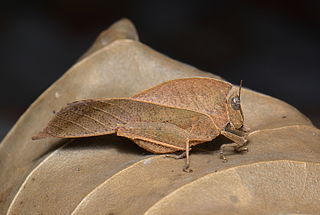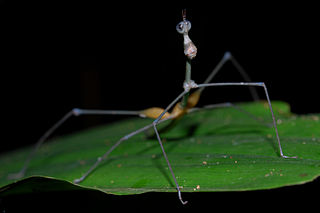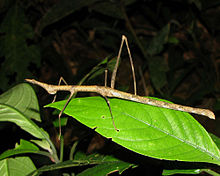
The grasshopper subfamily Acridinae, sometimes called silent slant-faced grasshoppers, belong of the large family Acrididae in the Orthoptera: Caelifera.

The Caelifera are a suborder of orthopteran insects. They include the grasshoppers and grasshopper-like insects, as well as other superfamilies classified with them: the ground-hoppers (Tetrigoidea) and pygmy mole crickets (Tridactyloidea). The latter should not be confused with the mole crickets (Gryllotalpidae), which belong to the other Orthopteran sub-order Ensifera.

Tetrigidae is an ancient family in the order Orthoptera, which also includes similar families such as crickets, grasshoppers, and their allies. Species within the Tetrigidae are variously called groundhoppers, pygmy grasshoppers, pygmy devils or "grouse locusts".

Nsenene is the Luganda name for Ruspolia differens: a bush cricket in the tribe Copiphorini of the 'cone-head' subfamily. It is often confused with the closely related Ruspolia nitidula.

Pyrgomorphidae is a family of grasshoppers in the order Orthoptera; it is the only family in the superfamily Pyrgomorphoidea. Pyrgomorphidae are found worldwide in tropical and warm temperate regions, but the vast majority of the family's approximately 500 species are from Africa, Asia and Australia. Their name is probably derived from pyrgos meaning "tower": a reference to the form (morph) of the head in the type genus Pyrgomorpha and other genera.

The Copiphorini are a tribe of bush crickets or katydids in the family Tettigoniidae. Previously considered a subfamily, they are now placed in the subfamily Conocephalinae. Like some other members of Conocephalinae, they are known as coneheads, grasshopper-like insects with an extended, cone-shaped projection on their heads that juts forward in front of the base of the antennae.

Pamphagidae is a family of grasshoppers belonging to the superfamily Acridoidea. The species in this family can be found in Africa, Europe and Asia.

Conocephalinae, meaning "conical head", is an Orthopteran subfamily in the family Tettigoniidae.

Romaleinae is a subfamily of lubber grasshoppers in the family Romaleidae, found in North and South America. More than 60 genera and 260 described species are placed in the Romaleinae.

Xenocatantops is a genus of grasshoppers in the subfamily Catantopinae and tribe Catantopini. Species can be found in Africa, India, China, Indo-China and Malesia.

Poekilocerus is a genus of grasshoppers in the family Pyrgomorphidae and the monotypic tribe Poekilocerini. Species are found in the northern half of Africa, and in Southwest and South Asia, often in arid or semi-arid areas.

Pyrgomorpha is the type genus of grasshoppers in the family Pyrgomorphidae and the tribe Pyrgomorphini. Species are found in Southern Europe, Africa and the middle East, through to India and Mongolia.

Batrachideinae is a subfamily of groundhoppers or pygmy grasshoppers. There are thought to be 20 genera in Batrachideinae, with genera found in the Americas, Africa, Asia and Australia.

Copiocerinae is a subfamily of short-horned grasshoppers in the family Acrididae. There are at least 20 genera in Copiocerinae, found in southern North America, Central America, and South America.

Chorotypus is a genus of Asian grasshoppers in the family Chorotypidae; species can be found in: India, Indochina and Malesia.

Eyprepocnemis is a genus of grasshoppers in the subfamily Eyprepocnemidinae with species found in Africa, Southern Europe through to tropical Asia.

Cladonotinae is a subfamily of groundhoppers containing more than 70 genera and 260 described species. These insects are found in tropical areas world-wide.

Proscopiinae is a subfamily of grasshoppers in the family Proscopiidae. There are more than 20 genera and 190 described species, found in South America.
Xeniinae is a subfamily of grasshoppers in the family Proscopiidae. Xeniinae has 3 genera, 2 extant and 1 extinct, and about 16 described species, found in South America.
Pterophyllini is a tribe of true katydids in the family Tettigoniidae. There are about 16 genera and more than 40 described species in Pterophyllini.

















